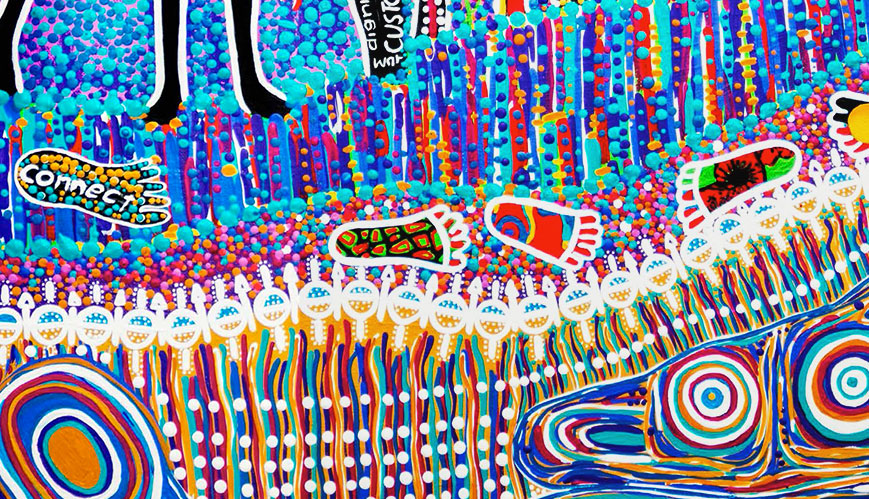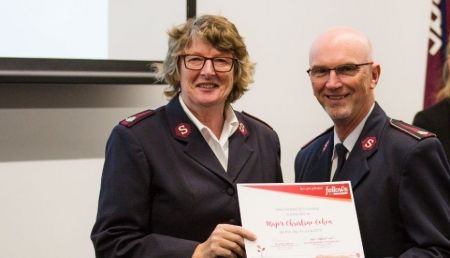The yarning circle

The yarning circle
12 July 2018
The Aboriginal and Torres Strait Islander "yarning circle" is a place of connection, hope and new outlooks and an important part of Indigenous culture.
As Australia celebrates NAIDOC Week, we take a look at the Aboriginal and Torres Strait Islander “yarning circle” – from an Indigenous and non-Indigenous perspective.
A yarning, story or dialogue circle, is an important process within Aboriginal and Torres Strait Islander culture. It has been used by Indigenous peoples from around the world for centuries to learn from a collective group, build respectful relationships, and to preserve and pass on cultural knowledge.
“As you sit side by side with others in a circle, there is a beautiful physical and spiritual connection that takes place, said Sue Hodges, Aboriginal and Torres Strait Islander Engagement Coordinator for the NSW and ACT Division.
“When you sit in a circle, there is nowhere to hide. You are exposed. You have to speak truthfully, to be open and honest as you look people in the face and talk about whatever the topic might be.
“This might be in a family, around a campfire, at a workplace or in a government office. Everyone has always used it in our culture and people come, expecting to be honest.”
Sue explains that, although the yarning circle concept can make people, “especially westerners who are used to hiding people, books and desks in a typical classroom setting”, uneasy, it has been incorporated into many different situations, including professional training.
She gave the example of Chris Sarra, an Australian educationalist of Italian and Aboriginal heritage, who has used yarning circles as part of the “stronger, smarter” workshops to improve outcomes for Aboriginal and Torres Strait Islander children.
“The circle brings teachers and principals together where they can’t hide emotionally but could discuss the issues openly in a safe and positive environment,” Sue explained.
“We also use these circles in kids’ camps, prison ministry, and for women who are isolated in their own communities.”
“This is our way of doing things and I have used the concept so many times is different contexts. If you can learn to let yourself go, to be open about your thoughts and feelings and not be confronted, it will change you. It’s very therapeutic.”
Susan Cook, an Indigenous problem gambling financial counsellor for The Salvation Army’s Moneycare Queensland, in Cairns, shared about the financial counselling yarning circles she has been a part of.
“We use them at our conferences with financial counsellors and literacy workers for external dispute resolution,” Sue said. “Indigenous and non-Indigenous people who work primarily in Indigenous communities attend.
“The circles give us the freedom to speak about what’s happening in our communities and what we’re seeing, without being judged - it’s a safe environment.
“It gives us new ideas and perspectives, gives us support, and puts us all on the same page.”
Yarning circles – a new way to listen
Major Chris Cohen, who serves as Chaplain at Southport Courts on the Gold Coast and in Brisbane Women’s and Numinbah Correctional Centres, spent a week last year as part of an Indigenous story or yarning circle.
This was part of Major Chris’ Salvation Army 2017 Fellows program scholarship, sponsored by Aged Care Plus. The focus of the scholarship is “Telling our stories in ways that make us stronger: Narrative therapy and community work through an Aboriginal and Torres Strait Islander lens”.
The story circle – a place where Indigenous aunties train their own people in how to draw out the inner strengths of a person as they share their story – and so enable that person to build on those strengths and to go from a place of brokenness to a strong, positive and dignified future – was the “hands on” research component of the scholarship.
Below, Major Chris shares her reflections from that experience:
For me, the privilege of being part of yarning circles and sitting with, and under the leadership of the elders, was learning a new way to listen.
Toddlers listen to adults; they absorb the sounds, the sentiments, the expressions, and they take it all in. It’s like an osmosis of listening.
Jesus was a listener. He asked people what it was they needed, and he listened to them.
He absorbed the situation. He wasn’t just listening to the words the person gave, but the need the person presented would permeate into him.
He would get the words, make eye contact, sit in the context of that space – and it’s like that in yarning circles. It’s listening to someone with your eyes, your spirit, as part of the space around you.
It’s a sacred space, prayerfully prepared, and honoured, as the silence is honoured. When we speak, it’s by faith and in prayer.
We gift power, strength and honour to the speaker as Jesus did, touching people by asking what it is that they need.
The storyteller who owns the story of whatever it is, they speak their story.
 Major Chris Cohen receives her Fellows Program scholarship from Lieutenant-Colonel Kelvin Pethybridge.
Major Chris Cohen receives her Fellows Program scholarship from Lieutenant-Colonel Kelvin Pethybridge.
I’m not comparing us to Jesus, of course, but those in the yarning circle are there to bring understanding and wisdom – but it’s still that person’s story.
My knowledge can speak into you but it must be God’s Spirit that brings healing.
In the yarning circles with my Aboriginal and Torres Strait Islander sisters, there is a healing that comes from listening. The silence creates courage for the person to speak, and that leads to their healing.
If I can honour the storyteller by gifting them my silence, my attention, the space that I have prayed into, then I’m listening and might be privileged to get an insight into their story, their life and world, open their closed door.
It’s too easy to run off at the mouth, with our messaging, our rhetoric, our propaganda, and our clinical talk. For too long the colonial world, the White majority world, has demanded the right to speak into the world of our Aboriginal and Torres Strait Islander sisters and brothers.
We need to close our mouths and to listen. We don’t know their story. We don’t understand the spiritual, psychological and emotional impacts the past has had on them. We don’t understand the brokenness of their community.
We’ve forgotten that relationships are incredibly important, built on space making and listening.
We’ve largely lost the sense of honouring a person by listening to them, when there is no dollar value attached, but when a story is so much more precious than gold.
We often find it hard not to jump in and speak when someone else is sharing, or to not respond immediately when a person is finished.
The yarning circle showed me that I don’t have to respond straight away. Is silence, in prayer, we pray through what we have learned and ask the Lord how he would have us respond.
We don’t respond like a robot, or with policies, processes and procedures. We ask what gives life, what comes from the Spirit of God, and we are quiet.
Another set of lessons is around what is referred to as re-hearing.
If a person is telling their story and shares their guilt and shame over something that’s happened, or what they feel about themselves, the circle acknowledges what has happened, and then repackages it.
They ask questions, seek a fragment of hope, and then build on that.
The focus is on the life, hope and potential of the person, God’s plan for them, and planting a new seed that can grow.
The person hears their story in a different way and can move forward.
This all takes time, and silence. Those in the circle think and pray, mull over matters and draw on their collective and individual wisdom and experience.
They don’t blurt out the first thing that comes to mind.
They are asking what people need from them, and what concerns those people today.
Comments
Genuine listening. Listening with intentional silence that allows us to “hear”. The heart of the speaker is the ministry of pastoral care and Christ’s love that the Chaplain’s presence in prisons of life - be they isolation, aged care, loneliness, Correctional centres, mental health trauma or racism ... present
A great reminder for us all to stop, look and listen. As someone said to me once, we have two ears to listen and one mouth to speak.